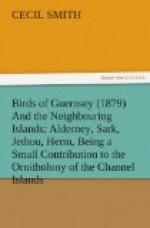[14] Rim. Gu., p. 35.
[15] Query, was this done by a migratory flock, as peas would be ripe about June or July, when migratory flocks of Wood Pigeons would not be likely to occur; or was the damage to newly sown peas in the spring?
[16] For one instance see notice of the Quail; and the bird-stuffer had several other eggs besides those in the same nest as the Quails.
[17] Fide Mr. MacCulloch.
[18] See ‘Dresser’s Birds of Europe.’
[19] For the last, see Temminck’s ‘Man, d’Ornithologie.’
[20] See ‘Zoologist’ for 1867, p. 829.
[21] Temminck, ‘Man. d’Ornithologie.’
[22] See Temminck, ‘Man. d’Ornithologie.’
[23] The one above mentioned.
[24] See ‘Zoologist’ for 1870, p. 2244.
[25] “Hucard” in Guernsey French (see ‘Metevier’s Dictionary,’) who also says “Notre Hucard est le Whistling Swan ou Hooper des Anglais.”
[26] See Temminck’s ‘Man. d’Ornithologie.’
[27] See also Metivier’s Dictionary.
[28] See note in ‘Zoologist’ for 1866.
[29] ’De la Mue du Bec et des Ornements Palpebraux du Macareux Arctique apres la Saison des Amours.’ Par le Docteur Louis Bureau; ’Bulletin de la Societe Zoologique de France.’
[30] ‘Zoologist’ for 1869.
[31] See Temininck, ‘Man. d’Ornithologie.’
[32] Temminck, ‘Man. d’Ornithologie.’
[33] Le Tas is often written L’Etat, but, as Professor Ansted says, “There can be no doubt it alludes to the form of the rock, viz., ‘Tas,’ a heap such as is made with hay or corn.”
[34] See Temminck’s ‘Man. d’Ornithologie.’
[35] Buffon.
[36] See Temminck’s ‘Man. d’Ornithologie.’
[37] See ‘Zoologist’ for 1869, p. 1560.
[38] See Temminck, ‘Man. d’Ornithologie.’
[39] This is since my note to Mr. Dresser, published in his ’Birds of Europe,’ when I said I had never seen it in the Channel Islands, although it probably occasionally occurred there.
INDEX.
Auk, Little, 178
Bittern, 152
Bittern, American, 153
Bittern, Little, 154
Blackbird, 34
Blackcap, 52
Brambling, 72
Bullfinch, 79
Bunting, 70
Bunting, Snow, 70
Bunting, Yellow, 71
Bustard, Little, 117
Buzzard, Common, 14
Buzzard, Rough-legged, 14




